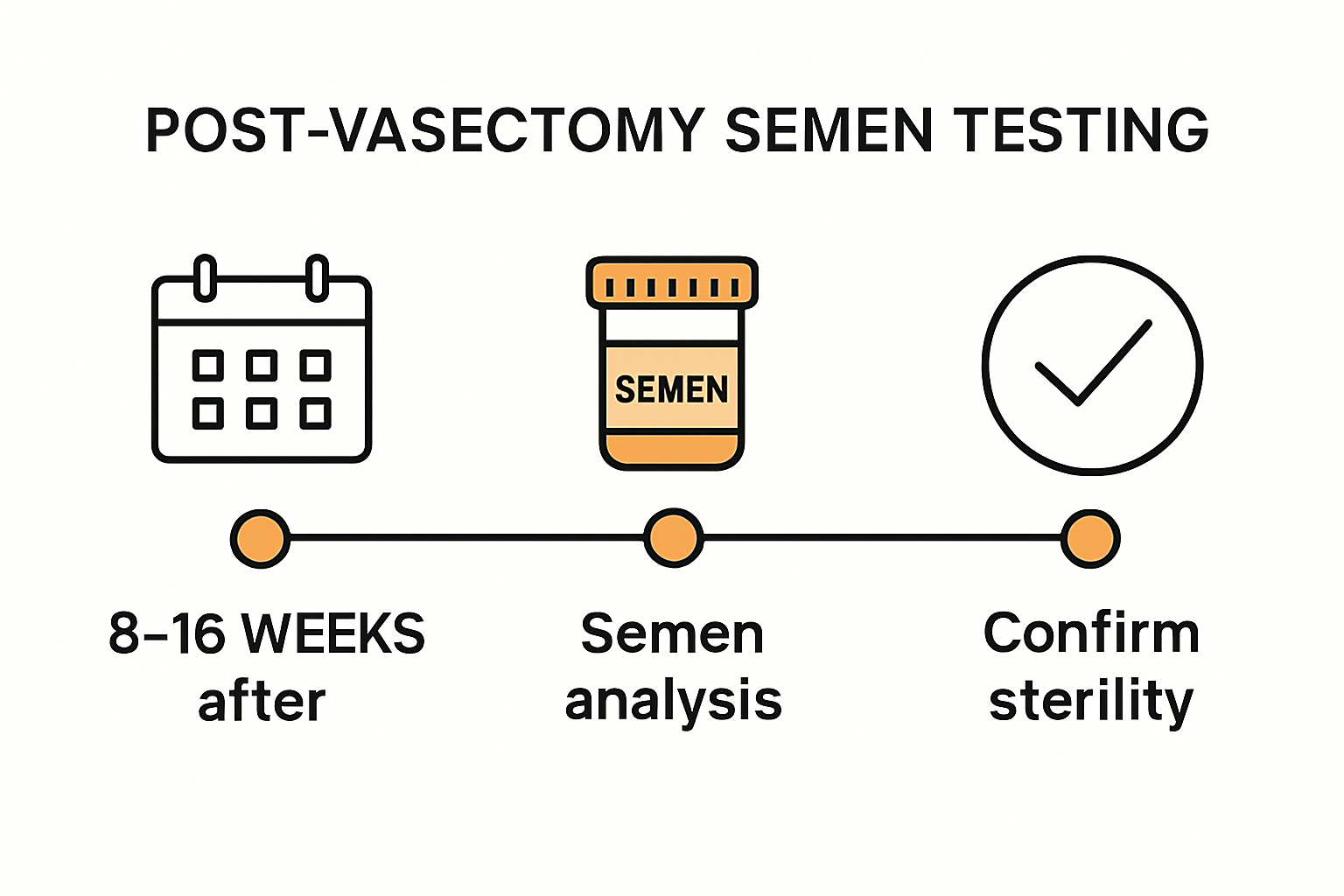Figuring out when to take a post vasectomy semen test comes with a crucial detail many overlook. Roughly 1 in 2,000 vasectomies fail if proper follow up testing is skipped. Most men think the procedure itself means instant results and worry is over. Not true. The real confirmation takes place weeks later with carefully timed tests, and getting that timing wrong could mean risking an unexpected pregnancy. Here’s what actually matters when it comes to post vasectomy semen test timing.
Table of Contents
- Why Post Vasectomy Semen Testing Matters
- Ideal Timing For Your First Semen Test
- What Happens During Your Semen Test
- Understanding Your Semen Test Results
Quick Summary
| Takeaway | Explanation |
|---|---|
| Post vasectomy semen testing is essential for confirming sterility | A vasectomy does not guarantee immediate sterility; testing is necessary to ensure no viable sperm remains in the reproductive tract. |
| Timing for the first semen test is critical | Initial testing is recommended 8 to 16 weeks post-vasectomy, with a minimum of 12 weeks and at least 20 ejaculations to ensure accurate results. |
| Proper preparation enhances testing reliability | Abstaining from ejaculation for 2-5 days before the test and following collection guidelines are vital for obtaining accurate semen analysis. |
| Understanding test outcomes is key to reproductive health | Test results can classify as cleared, borderline, or not cleared, which will dictate future reproductive strategies and the need for further testing. |
| Continue alternative birth control until confirmed sterility | Patients should maintain current contraception methods until a healthcare provider confirms complete absence of sperm through testing. |
Why Post Vasectomy Semen Testing Matters
A vasectomy represents a significant decision in a man’s reproductive life, but the procedure alone does not guarantee immediate sterility. Post vasectomy semen testing is the critical final step that confirms the success of the surgical intervention and provides men with confidence in their contraceptive protection.
Understanding Vasectomy Effectiveness
Contrary to popular belief, a vasectomy does not result in immediate sterility. Sperm can remain present in the reproductive tract for months after the procedure. American Urological Association recommends comprehensive semen analysis to verify complete absence of viable sperm. Typically, men will need multiple post vasectomy semen test samples to confirm zero sperm count.
Statistically, approximately 1 in 2,000 vasectomies fail without proper follow up testing. This means skipping post procedure semen analysis could potentially lead to unexpected pregnancy. The testing process involves submitting semen samples at specific intervals to ensure complete reproductive tract clearance.
The Critical Timing of Semen Testing

Proper timing for post vasectomy semen testing is paramount. Most urologists recommend initial testing approximately 8 to 16 weeks after the vasectomy procedure. During this timeframe, most remaining sperm will have been cleared from the reproductive system. The recommended protocol typically involves:
- Submitting 1-2 semen samples
- Waiting recommended interval after vasectomy
- Confirming zero sperm count before discontinuing alternative contraception
Preventing Potential Reproductive Complications
Skipping or delaying post vasectomy semen testing can lead to significant risks. Mayo Clinic emphasizes that premature cessation of backup contraception methods before confirmed sterility could result in unintended pregnancy. Professional medical guidance suggests continuing alternative birth control until a healthcare provider confirms complete sterility through comprehensive semen analysis.
The semen testing process provides more than just pregnancy prevention. It offers men psychological reassurance and concrete medical confirmation that their vasectomy has successfully achieved its intended purpose of contraception. This scientific verification helps eliminate uncertainty and provides clear medical documentation of the procedure’s effectiveness.
The video placeholder is intentionally added here to visually clarify the process of sperm clearance and why timing is critical.
While the testing might seem inconvenient, it represents a small investment of time compared to the long term reproductive certainty it provides. Men who complete thorough post vasectomy semen testing demonstrate responsible medical decision making and commitment to their reproductive health strategy.
Ideal Timing for Your First Semen Test
Determining the optimal moment for your first post vasectomy semen test involves careful consideration of multiple medical and biological factors. While many men are eager to confirm their sterility, rushing the process can lead to inaccurate results and potential reproductive risks.
Understanding Sperm Clearance Timeframes
After a vasectomy, sperm do not immediately disappear from the reproductive system. University of Virginia Urology recommends waiting approximately 12 weeks (3 months) and completing at least 20 ejaculations before collecting the first semen specimen. This waiting period allows sufficient time for post vasectomy semen test timing to capture an accurate representation of sperm clearance.
Medical professionals emphasize that individual healing and sperm elimination rates can vary. Some men might require slightly longer periods to achieve complete sterility. The recommended timeline balances scientific precision with practical patient experience, ensuring the most reliable testing outcomes.
Critical Factors Influencing Test Timing
Several key considerations impact the ideal timing for your first semen test:
- Total number of ejaculations post procedure
- Individual reproductive tract healing speed
- Surgical technique employed during vasectomy
- Personal metabolic and physiological factors
International clinical guidelines suggest collecting the initial semen sample between 12 to 16 weeks post vasectomy. Male Sexual Health Research Institute highlights that this timeframe maximizes the likelihood of confirming azoospermia (complete absence of sperm).
Preparing For Accurate Semen Analysis
Proper preparation increases the reliability of your post vasectomy semen test. Urologists recommend several strategic approaches to ensure precise results:
- Abstain from ejaculation for 2-5 days before sample collection
- Use recommended collection methods provided by your healthcare facility
- Follow strict specimen transportation guidelines
- Schedule multiple follow up tests as recommended by your urologist
While waiting can feel challenging, patience during the post vasectomy semen testing process is crucial. Rushing or collecting samples too early can provide misleading results, potentially compromising your understanding of reproductive status. Professional medical guidance remains the most reliable pathway to confirming vasectomy success and achieving desired contraceptive outcomes.
What Happens During Your Semen Test
 A post vasectomy semen test is a precise medical procedure designed to confirm the success of your vasectomy. Understanding the process can help alleviate anxiety and ensure you approach the test with confidence and clarity.
A post vasectomy semen test is a precise medical procedure designed to confirm the success of your vasectomy. Understanding the process can help alleviate anxiety and ensure you approach the test with confidence and clarity.
Sample Collection Procedures
Cambridge University Hospitals notes that semen analysis involves a meticulous collection and examination process. Most healthcare facilities provide specific instructions to maximize testing accuracy. Typically, patients are asked to collect their semen sample through masturbation, either at home using a sterile collection container or directly at the medical facility.
Key preparation requirements often include:
- Abstaining from ejaculation for 2-5 days prior to testing
- Avoiding lubricants that might interfere with sperm assessment
- Delivering the sample to the laboratory within a specific timeframe
Patients must follow these guidelines precisely to ensure the post vasectomy semen test timing yields reliable results. Improper collection can potentially compromise the entire analysis.
Laboratory Microscopic Examination
Once the sample arrives at the laboratory, technicians perform a comprehensive microscopic assessment. Reproductive Medicine Research Center explains that the examination involves multiple critical steps:
- Measuring total semen volume (average ejaculate is approximately 2.5 ml)
- Conducting a high magnification sperm count
- Assessing sperm motility and potential presence
The primary objective is detecting any remaining viable sperm. A successful vasectomy result shows either zero sperm or only non motile sperm fragments. Laboratories use a “large volume assessment” technique to increase the likelihood of detecting even extremely low sperm counts.
Understanding Potential Test Outcomes
Semen test results typically fall into three primary categories:
- Cleared: No sperm detected, indicating successful vasectomy
- Borderline: Low sperm count requiring additional testing
- Not Cleared: Significant sperm presence necessitating further medical evaluation
Medical professionals often recommend multiple tests to confirm consistent results. If initial tests show any sperm presence, patients will need to continue using alternative contraception and schedule follow up analyses.
The semen test represents more than a medical procedure it is a critical step in confirming reproductive control. While the process might seem intimidating, it provides definitive medical confirmation of your vasectomy’s effectiveness. Approaching the test with preparedness and understanding can transform what might feel like an uncomfortable experience into a straightforward, professional medical assessment.
Remember that each test brings you closer to complete reproductive certainty. Patience and adherence to medical guidelines are key to achieving accurate and reliable results.
Understanding Your Semen Test Results
Navigating post vasectomy semen test results requires careful interpretation and professional medical guidance. The outcome of your test will determine your reproductive status and future contraceptive approach.
Interpreting Test Classifications
University of Virginia Urology emphasizes that patients remain considered fertile until at least one semen analysis confirms complete absence of viable sperm. The test results typically fall into three primary categories:
- Cleared Results: Zero or rare non motile sperm detected
- Borderline Results: Low sperm count requiring additional testing
- Not Cleared Results: Significant sperm presence indicating potential vasectomy failure
Each classification carries specific implications for your reproductive strategy and future medical follow up. Professional interpretation remains crucial in understanding these nuanced outcomes.
Navigating Unclear or Complex Results
Male Sexual Health Research Institute recommends continued alternative contraception until written confirmation of vasectomy success is received. Unclear results might necessitate:
- Additional semen sample submissions
- Repeat testing at specified intervals
- Consultation with urological specialists
- Potential surgical reassessment
Patients should never assume sterility without explicit medical confirmation. Even rare sperm presence can indicate potential fertility risk.
Next Steps After Testing
Receiving your test results requires strategic medical decision making. Key considerations include:
- Maintaining current contraception methods until confirmed sterility
- Scheduling follow up appointments if results are inconclusive
- Understanding potential reasons for persistent sperm presence
- Discussing comprehensive reproductive health strategies with healthcare providers
The post vasectomy semen test timing and result interpretation represent critical components of your reproductive health management. While waiting for definitive results can feel anxiety producing, systematic medical assessment ensures the most accurate understanding of your reproductive status.
Remember that each test brings you closer to complete reproductive certainty. Professional medical guidance, patience, and adherence to recommended protocols remain essential in achieving reliable vasectomy confirmation.
Frequently Asked Questions
When should I schedule my first post vasectomy semen test?
You should schedule your first post vasectomy semen test approximately 8 to 16 weeks after the procedure, with a minimum of 12 weeks and at least 20 ejaculations to ensure accurate results.
Why is post vasectomy semen testing important?
Post vasectomy semen testing is crucial to confirm the absence of viable sperm, as a vasectomy does not guarantee immediate sterility. Up to 1 in 2,000 vasectomies may fail without proper follow-up testing.
What should I do to prepare for my semen test?
To prepare for your semen test, abstain from ejaculation for 2-5 days before the test and follow specific collection instructions provided by your healthcare provider to ensure accurate results.
What do the results of a post vasectomy semen test mean?
Test results can be classified as cleared (no sperm detected), borderline (low sperm count), or not cleared (significant sperm presence). Professional guidance is essential in interpreting these results and determining your contraceptive strategy.





